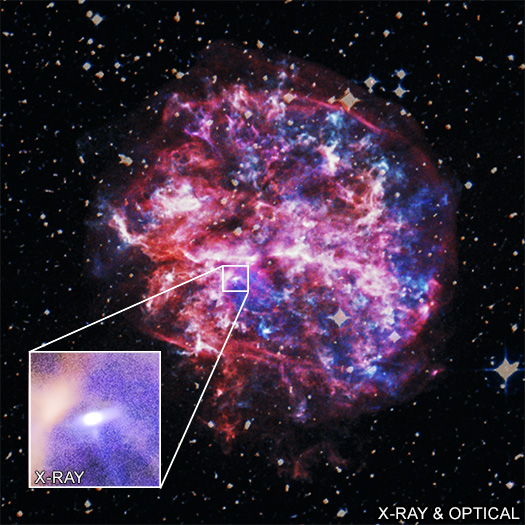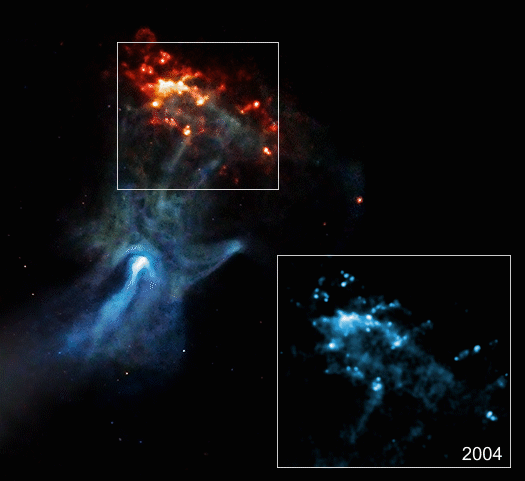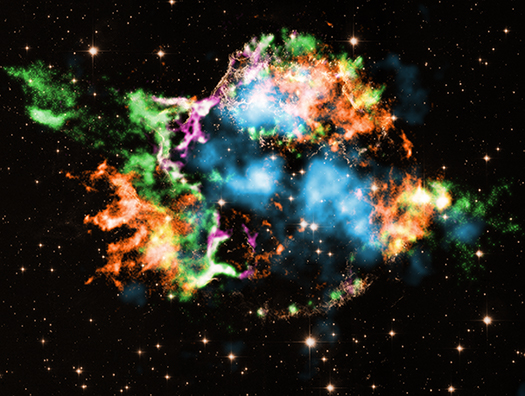Supernovas & Supernova Remnants
Chandra’s Sight Sheds New Light: Gathering Insight on Earth, Life, and the X-ray Bright
We welcome Ian Brunton, a research scientist currently at NASA Johnson Space Center in the Astromaterials Research and Exploration Science Division as our guest blogger. In this post, he describes his team’s work below on the effects that a nearby supernova may have on an Earth-like planet and its biosphere. Ian first became involved with this area of research as an astronomy student of Brian Fields at the University of Illinois. He will soon be continuing his academic studies as a PhD student at Caltech in the Division of Geological and Planetary Sciences.
Much has been said about the extraordinary advancements throughout the field of astronomy, particularly regarding the innovative ways in which we can now observe the universe across the electromagnetic spectrum. Chandra has of course been one of the instruments at the forefront of this exploration for the last couple of decades, illuminating the universe in the X-ray band. These new ways of looking at our universe have served to confirm, alter, or entirely upend our prior notions of certain astrophysical processes.
What I personally find most intriguing is how these new observations can then be integrated into the knowledge and pursuits of other scientific disciplines, be it planetary science, atmospheric chemistry, geology, etc.
One of the most fascinating processes (if I may say so myself…) that orbital X-ray telescopes are especially handy for are supernovae, i.e., exploding stars! I’ll elaborate a bit on exactly why below, but first, some background on nearby supernovae and Earth is needed since our project really builds upon a lot of previous work in the field.
Everyone loves a good astronomical explosion, and supernovae — typically characterized by the wondrous spectacle of their initial outbursts — are some of the best explosions in the known universe. In the blink of an eye, these monstrous events can outshine the entire combined output of stars in a galaxy, launching neutrinos, photons, and stellar material out into the abyss of the interstellar medium.
Unlocking the Mysteries of the Historic Tycho Supernova
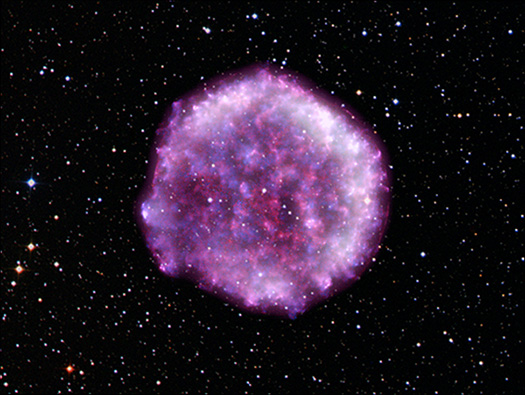
Tycho's Supernova Remnant
Credit: X-ray (IXPE: NASA/ASI/MSFC/INAF/R. Ferrazzoli, et al.), (Chandra: NASA/CXC/RIKEN & GSFC/T. Sato et al.) Optical: DSS, Image processing: NASA/CXC/SAO/K. Arcand, L. Frattare & N. Wolk
This image provides a new look at the Tycho supernova remnant, named for Danish astronomer Tycho Brahe who noticed the bright glow of this new “star” in the constellation Cassiopeia more than 450 years ago. Astronomers used NASA’S Imaging X-ray Polarimetry Explorer (IXPE) to study polarized light from Tycho, the debris from an exploded star, as described in IXPE’s latest press release. IXPE revealed, for the first time, the geometry of the magnetic fields close to the supernova’s blast wave, which is still propagating from the initial explosion and forms a boundary around the ejected material. Understanding the magnetic field geometry allows scientists to further investigate how particles are accelerated there.
In this composite image, data from IXPE (dark purple and white) have been combined with those from NASA’s Chandra X-ray Observatory (red and blue), which were overlaid with the stars in the field of view seen by the Digitized Sky Survey.
NASA's IXPE Helps Unlock the Secrets of Famous Exploded Star

Cassiopeia A
Credit: X-ray: Chandra: NASA/CXC/SAO, IXPE: NASA/MSFC/J. Vink et al.; Optical: NASA/STScI
For the first time, astronomers have measured and mapped polarized X-rays from the remains of an exploded star, using NASA’s Imaging X-ray Polarimetry Explorer (IXPE). The findings, which come from observations of a stellar remnant called Cassiopeia A, shed new light on the nature of young supernova remnants, which accelerate particles close to the speed of light.
Launched on Dec. 9, 2021, IXPE, a collaboration between NASA and the Italian Space Agency, is the first satellite that can measure the polarization of X-ray light with this level of sensitivity and clarity.
All forms of light — from radio waves to gamma rays — can be polarized. Unlike the polarized sunglasses we use to cut the glare from sunlight bouncing off a wet road or windshield, IXPE’s detectors maps the tracks of incoming X-ray light. Scientists can use these individual track records to figure out the polarization, which tells the story of what the X-rays went through.
Cassiopeia A (Cas A for short) was the first object IXPE observed after it began collecting data. One of the reasons Cas A was selected is that its shock waves — like a sonic boom generated by a jet — are some of the fastest in the Milky Way. The shock waves were generated by the supernova explosion that destroyed a massive star after it collapsed. Light from the blast swept past Earth more than three hundred years ago.
Setting the Clock on a Stellar Explosion
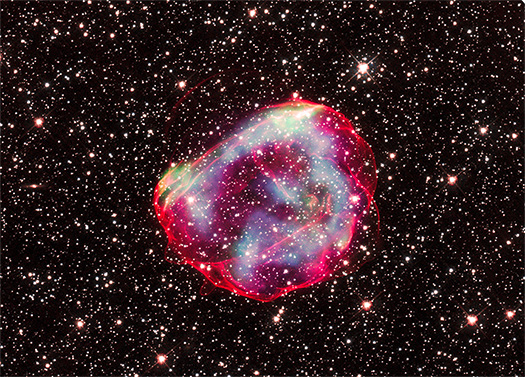
Supernova Remnant 0519-69.0
Credit: X-ray: NASA/CXC/GSFC/B. J. Williams et al.; Optical: NASA/ESA/STScI
While astronomers have seen the debris from scores of exploded stars in the Milky Way and nearby galaxies, it is often difficult to determine the timeline of the star’s demise. By studying the spectacular remains of a supernova in a neighboring galaxy using NASA telescopes, a team of astronomers has found enough clues to help wind back the clock.
The supernova remnant called SNR 0519-69.0 (SNR 0519 for short) is the debris from an explosion of a white dwarf star. After reaching a critical mass, either by pulling matter from a companion star or merging with another white dwarf, the star underwent a thermonuclear explosion and was destroyed. Scientists use this type of supernova, called a Type Ia, for a wide range of scientific studies ranging from studies of thermonuclear explosions to measuring distances to galaxies across billions of light-years.
NASA's Chandra Catches Pulsar in X-ray Speed Trap
The G292.0+1.8 supernova remnant contains a pulsar moving at over a million miles per hour. This image features data from NASA's Chandra X-ray Observatory (red, orange, yellow, and blue), which was used to make this discovery, as discussed in our latest press release. The X-rays were combined with an optical image from the Digitized Sky Survey, a ground-based survey of the entire sky.
Pulsars are rapidly spinning neutron stars that can form when massive stars run out of fuel, collapse and explode. Sometimes these explosions produce a "kick," which is what sent this pulsar racing through the remains of the supernova explosion. An inset shows a close-up look at this pulsar in X-rays from Chandra.
To make this discovery, the researchers compared Chandra images of G292.0+1.8 taken in 2006 and 2016. A pair of supplemental images show the change in position of the pulsar over the 10-year span. The shift in the source's position is small because the pulsar is about 20,000 light-years from Earth, but it traveled about 120 billion miles over this period. The researchers were able to measure this by combining Chandra's high-resolution images with a careful technique of checking the coordinates of the pulsar and other X-ray sources by using precise positions from the Gaia satellite.
NASA's IXPE Sends First Science Image
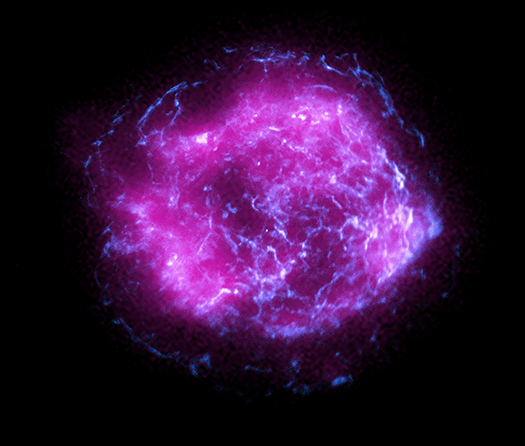
Cassiopeia A
Credit: NASA/CXC/SAO/IXPE
NASA’s Imaging X-Ray Polarimetry Explorer, which launched into space Dec. 9, 2021, delivered its first imaging data since completing its month-long commissioning phase.
All instruments are functioning well aboard the observatory, which is on a quest to study some of the most mysterious and extreme objects in the universe.
IXPE first focused its X-ray eyes on Cassiopeia A (Cas A), an object consisting of the remains of a star that exploded in the 17th century. The shock waves from the explosion have swept up surrounding gas, heating it to high temperatures and accelerating cosmic ray particles to make a cloud that glows in X-ray light. Other telescopes, including Chandra, have studied Cas A before, but IXPE will allow researchers to examine it in a new way.
The newly-release image combines IXPE and Chandra data of Cas A. The saturation of the magenta color corresponds to the intensity of X-ray light observed by IXPE, which has been overlaid on high-energy X-rays, shown in blue, from Chandra. With different kinds of detectors, Chandra and IXPE have different levels of angular resolution, or sharpness. The IXPE data in this new image contain collected from Jan. 11 to 18, while the Chandra data come from observations over the 22-year mission thus far.
An Expanse of Light
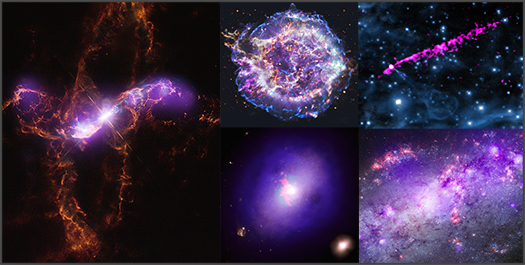
An Expanse of Light
Credit: X-ray: NASA/CXC/SAO; Optical: NASA/STScI, Palomar Observatory, DSS;
Radio: NSF/NRAO/VLA; H-Alpha: LCO/IMACS/MMTF
The recent launches of the James Webb Space Telescope (Webb) and the Imaging X-ray Polarimetry Explorer (IXPE) by NASA and its international partners are excellent reminders that the universe emits light or energy in many different forms. To fully investigate cosmic objects and phenomena, scientists need telescopes that can detect light across what is known as the electromagnetic spectrum.
This gallery provides examples of the ways that different types of light from telescopes on the ground and in space can be combined. The common thread in each of these selections is data from NASA's Chandra X-ray Observatory, illustrating how X-rays — which are emitted by very hot and energetic processes — are found throughout the Universe.
When a Stable Star Explodes
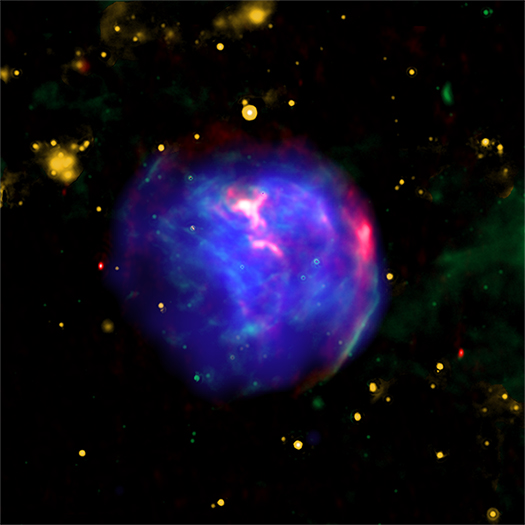
Supernova Remnant G344.7-0.1
Credit: X-ray: NASA/CXC/Tokyo Univ. of Science/K. Fukushima, et al.; IR: NASA/JPL/Spitzer; Radio: CSIRO/ATNF/ATCA
White dwarfs are among the most stable of stars. Left on their own, these stars that have exhausted most of their nuclear fuel — while still typically as massive as the Sun — and shrunk to a relatively small size can last for billions or even trillions of years.
However, a white dwarf with a nearby companion star can become a cosmic powder keg. If the companion's orbit brings it too close, the white dwarf can pull material from it until the white dwarf grows so much that it becomes unstable and explodes. This kind of stellar blast is called a Type Ia supernova.
While it is generally accepted by astronomers that such encounters between white dwarfs and "normal" companion stars are one likely source of Type Ia supernova explosions, many details of the process are not well understood. One way to investigate the explosion mechanism is to look at the elements left behind by the supernova in its debris or ejecta.
Cosmic Hand Hitting a Wall
Motions of a remarkable cosmic structure have been measured for the first time, using NASA's Chandra X-ray Observatory. The blast wave and debris from an exploded star are seen moving away from the explosion site and colliding with a wall of surrounding gas.
Astronomers estimate that light from the supernova explosion reached Earth about 1,700 years ago, or when the Mayan empire was flourishing and the Jin dynasty ruled China. However, by cosmic standards the supernova remnant formed by the explosion, called MSH 15-52, is one of the youngest in the Milky Way galaxy. The explosion also created an ultra-dense, magnetized star called a pulsar, which then blew a bubble of energetic particles, an X-ray-emitting nebula.
Bubbles With Titanium Trigger Titanic Explosions
Astronomers using NASA's Chandra X-ray Observatory have announced the discovery of an important type of titanium, along with other elements, blasting out from the center of the supernova remnant Cassiopeia A (Cas A). This new result, as outlined in our latest press release, could be a major step for understanding exactly how some of the most massive stars explode.
The different colors in this new image mostly represent elements detected by Chandra in Cas A: iron (orange), oxygen (purple), and the amount of silicon compared to magnesium (green). Titanium (light blue) detected previously by NASA's NuSTAR telescope at higher X-ray energies is also shown. These Chandra and NuSTAR X-ray data have been overlaid on an optical-light image from the Hubble Space Telescope (yellow).


